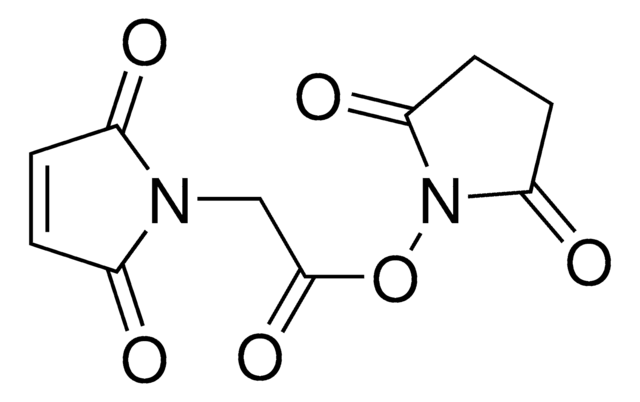803618
DTME (dithio-bis-maleimidoethane)
Sinónimos:
1,1′-(dithiodi-2,1-ethanediyl)bis-1H-Pyrrole-2,5-dione, 1-[2-[[2-(2,5-Dihydro-2,5-dioxo-1H-pyrrol-1-yl)ethyl]dithio]ethyl]-1H-pyrrole-2,5-dione, DTME
About This Item
Productos recomendados
Ensayo
≥90%
Formulario
powder
mol peso
312.37
idoneidad de la reacción
reagent type: cross-linking reagent
condiciones de almacenamiento
desiccated
solubilidad
DMSO or DMF: soluble
Condiciones de envío
ambient
temp. de almacenamiento
2-8°C
cadena SMILES
O=C(C=CC1=O)N1CCSSCCN2C(C=CC2=O)=O
InChI
1S/C12H12N2O4S2/c15-9-1-2-10(16)13(9)5-7-19-20-8-6-14-11(17)3-4-12(14)18/h1-4H,5-8H2
Clave InChI
SGVWDRVQIYUSRA-UHFFFAOYSA-N
Descripción general
Características y beneficios
- Reactive groups: maleimide (both ends)
- Reactive towards: sulfhydryl groups
- Long (13.3A), cleavable, sulfhydryl-to-sulfhydryl crosslinker, composed of maleimide groups and 11-atom disulfide spacer arm
- Water-insoluble—dissolve first in DMF or DMSO, then add to aqueous reaction buffers
- Cleavable by reduction of disulfide spacer arm with DTT, TCEP or other reducing agent
Precaución
Palabra de señalización
Warning
Frases de peligro
Clasificaciones de peligro
Acute Tox. 4 Dermal - Acute Tox. 4 Inhalation - Acute Tox. 4 Oral - Eye Irrit. 2 - Skin Irrit. 2 - STOT SE 3
Órganos de actuación
Respiratory system
Código de clase de almacenamiento
11 - Combustible Solids
Clase de riesgo para el agua (WGK)
WGK 3
Punto de inflamabilidad (°F)
Not applicable
Punto de inflamabilidad (°C)
Not applicable
Elija entre una de las versiones más recientes:
Certificados de análisis (COA)
It looks like we've run into a problem, but you can still download Certificates of Analysis from our Documentos section.
Si necesita más asistencia, póngase en contacto con Atención al cliente
¿Ya tiene este producto?
Encuentre la documentación para los productos que ha comprado recientemente en la Biblioteca de documentos.
Los clientes también vieron
Nuestro equipo de científicos tiene experiencia en todas las áreas de investigación: Ciencias de la vida, Ciencia de los materiales, Síntesis química, Cromatografía, Analítica y muchas otras.
Póngase en contacto con el Servicio técnico










